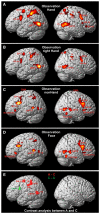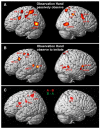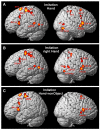ALE meta-analysis of action observation and imitation in the human brain
- PMID: 20056149
- PMCID: PMC4981639
- DOI: 10.1016/j.neuroimage.2009.12.112
ALE meta-analysis of action observation and imitation in the human brain
Abstract
Over the last decade, many neuroimaging studies have assessed the human brain networks underlying action observation and imitation using a variety of tasks and paradigms. Nevertheless, questions concerning which areas consistently contribute to these networks irrespective of the particular experimental design and how such processing may be lateralized remain unresolved. The current study aimed at identifying cortical areas consistently involved in action observation and imitation by combining activation likelihood estimation (ALE) meta-analysis with probabilistic cytoarchitectonic maps. Meta-analysis of 139 functional magnetic resonance and positron emission tomography experiments revealed a bilateral network for both action observation and imitation. Additional subanalyses for different effectors within each network revealed highly comparable activation patterns to the overall analyses on observation and imitation, respectively, indicating an independence of these findings from potential confounds. Conjunction analysis of action observation and imitation meta-analyses revealed a bilateral network within frontal premotor, parietal, and temporo-occipital cortex. The most consistently rostral inferior parietal area was PFt, providing evidence for a possible homology of this region to macaque area PF. The observation and imitation networks differed particularly with respect to the involvement of Broca's area: whereas both networks involved a caudo-dorsal part of BA 44, activation during observation was most consistent in a more rostro-dorsal location, i.e., dorsal BA 45, while activation during imitation was most consistent in a more ventro-caudal aspect, i.e., caudal BA 44. The present meta-analysis thus summarizes and amends previous descriptions of the human brain networks related to action observation and imitation.
Copyright 2009 Elsevier Inc. All rights reserved.
Figures







References
-
- Amunts K, Schleicher A, Bürgel U, Mohlberg H, Uylings HBM, Zilles K. Broca's region revisited: cytoarchitecture and intersubject variability. J. Comp. Neurol. 1999;41(2):319–341. - PubMed
-
- Amunts K, Schleicher A, Zilles K. Cytoarchitecture of the cerebral cortex—more than localization. NeuroImage. 2007;37(4):1061–1065. - PubMed
-
- Aziz-Zadeh L, Maeda F, Zaidel E, Mazziotta J, Iacoboni M. Lateralization in motor facilitation during action observation: a TMS study. Exp. Brain Res. 2002;144:127–131. - PubMed
Publication types
MeSH terms
Grants and funding
LinkOut - more resources
Full Text Sources

